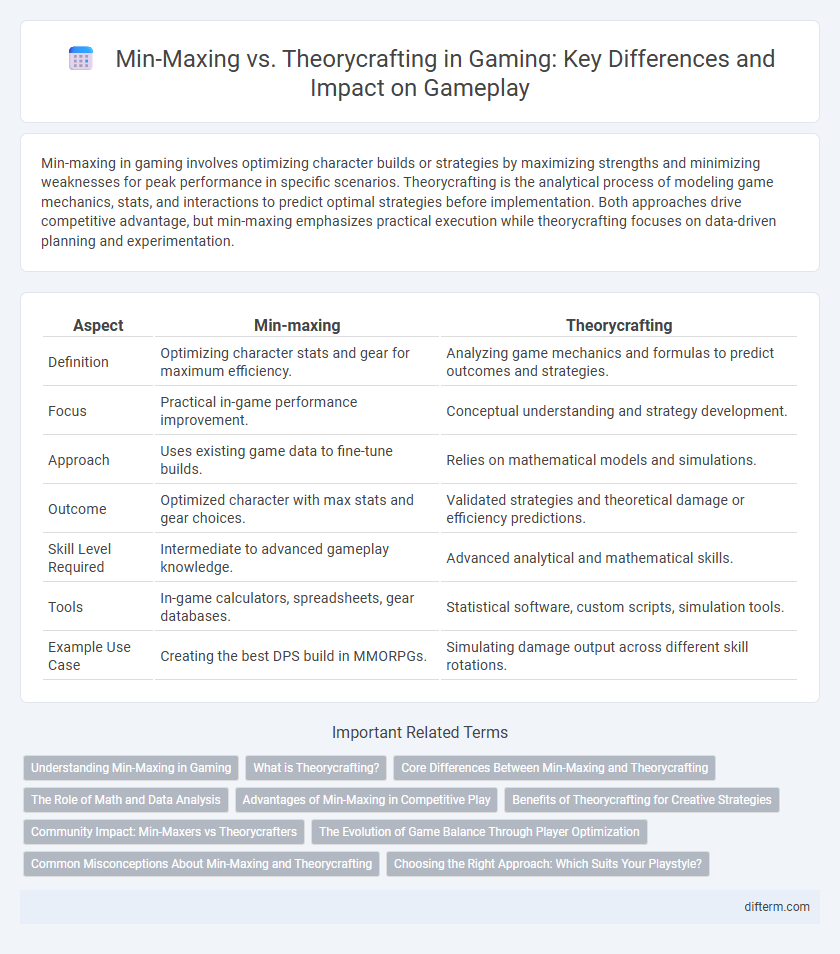Min-maxing in gaming involves optimizing character builds or strategies by maximizing strengths and minimizing weaknesses for peak performance in specific scenarios. Theorycrafting is the analytical process of modeling game mechanics, stats, and interactions to predict optimal strategies before implementation. Both approaches drive competitive advantage, but min-maxing emphasizes practical execution while theorycrafting focuses on data-driven planning and experimentation.
Table of Comparison
| Aspect | Min-maxing | Theorycrafting |
|---|---|---|
| Definition | Optimizing character stats and gear for maximum efficiency. | Analyzing game mechanics and formulas to predict outcomes and strategies. |
| Focus | Practical in-game performance improvement. | Conceptual understanding and strategy development. |
| Approach | Uses existing game data to fine-tune builds. | Relies on mathematical models and simulations. |
| Outcome | Optimized character with max stats and gear choices. | Validated strategies and theoretical damage or efficiency predictions. |
| Skill Level Required | Intermediate to advanced gameplay knowledge. | Advanced analytical and mathematical skills. |
| Tools | In-game calculators, spreadsheets, gear databases. | Statistical software, custom scripts, simulation tools. |
| Example Use Case | Creating the best DPS build in MMORPGs. | Simulating damage output across different skill rotations. |
Understanding Min-Maxing in Gaming
Min-maxing in gaming involves optimizing character stats, skills, or equipment to achieve the highest possible performance by minimizing weaknesses and maximizing strengths. This strategy requires deep knowledge of game mechanics, resource allocation, and statistical analysis to create the most effective builds or strategies. Understanding min-maxing allows players to gain competitive advantages and improve efficiency in gameplay by exploiting system loopholes and maximizing output.
What is Theorycrafting?
Theorycrafting in gaming involves analyzing game mechanics, statistics, and player data to devise optimal strategies and build configurations. It requires leveraging mathematical models and simulations to predict outcomes and improve in-game performance. This systematic approach helps players maximize efficiency and gain competitive advantages by understanding hidden mechanics and synergy effects.
Core Differences Between Min-Maxing and Theorycrafting
Min-maxing emphasizes optimizing character stats by maximizing strengths and minimizing weaknesses for peak performance, often relying on predefined formulas and rigid optimization strategies. Theorycrafting involves a broader analytical approach, including simulating different gameplay scenarios and experimenting with builds to explore potential strategies and mechanics beyond just numerical optimization. The core difference lies in min-maxing's focus on quantitative optimization versus theorycrafting's holistic exploration of game systems and strategic creativity.
The Role of Math and Data Analysis
Min-maxing leverages mathematical optimization to maximize character stats and resource efficiency, using precise calculations to enhance gameplay performance. Theorycrafting involves in-depth data analysis and simulation models to predict outcomes and inform strategic decisions within game mechanics. Both approaches rely heavily on quantitative methods to improve player effectiveness and optimize in-game strategies.
Advantages of Min-Maxing in Competitive Play
Min-maxing enhances competitive play by maximizing character stats and abilities to create the most efficient and powerful builds, giving players a distinct edge in high-stakes environments. It allows for optimized resource allocation and precise gameplay strategies that capitalize on every game mechanic's potential. This data-driven approach reduces variability, ensuring consistent performance against skilled opponents.
Benefits of Theorycrafting for Creative Strategies
Theorycrafting enables gamers to explore complex mechanics and devise innovative strategies beyond simple optimization, fostering unique playstyles and problem-solving approaches. By analyzing game systems deeply, players can predict outcomes and tailor tactics that adapt to various scenarios, enhancing overall gameplay experience. This creative experimentation often leads to discovering overlooked synergies and novel builds, enriching both individual and community engagement in gaming.
Community Impact: Min-Maxers vs Theorycrafters
Min-maxers drive intense competitive environments by optimizing gameplay strategies to peak efficiency, fostering a culture of precision and high performance within gaming communities. Theorycrafters contribute by developing detailed models and simulations that expand collective knowledge, enabling players to understand mechanics deeply and improve decision-making. The interplay between these groups cultivates a dynamic ecosystem where both practical skill and analytical insight enhance the overall gaming experience.
The Evolution of Game Balance Through Player Optimization
Min-maxing and theorycrafting represent two pivotal approaches in player optimization that have significantly influenced the evolution of game balance in modern gaming. By analyzing game mechanics and optimizing character builds or strategies, players push developers to constantly adjust variables, resulting in more nuanced and dynamic gameplay. This ongoing interaction between player-driven optimization and developer fine-tuning leads to a more balanced and engaging game environment.
Common Misconceptions About Min-Maxing and Theorycrafting
Min-maxing is often misunderstood as simply optimizing character stats without considering gameplay dynamics, whereas theorycrafting involves deep analysis of game mechanics to predict optimal strategies. Many players confuse min-maxing with reckless optimization, ignoring that effective min-maxing requires comprehensive theorycrafting to balance risk and reward. Both practices demand a nuanced understanding of game systems, where theorycrafting informs min-maxing decisions rather than existing as isolated approaches.
Choosing the Right Approach: Which Suits Your Playstyle?
Min-maxing focuses on optimizing game mechanics and character stats for maximum efficiency and performance, ideal for competitive players seeking clear numeric advantages. Theorycrafting involves creating and testing strategies, builds, and game mechanics to discover novel or unconventional approaches, suited for creative players who enjoy experimentation and deep game analysis. Selecting the right approach depends on your gaming goals: choose min-maxing for precision and dominance in gameplay or theorycrafting for innovation and strategic depth.
Min-maxing vs Theorycrafting Infographic

 difterm.com
difterm.com